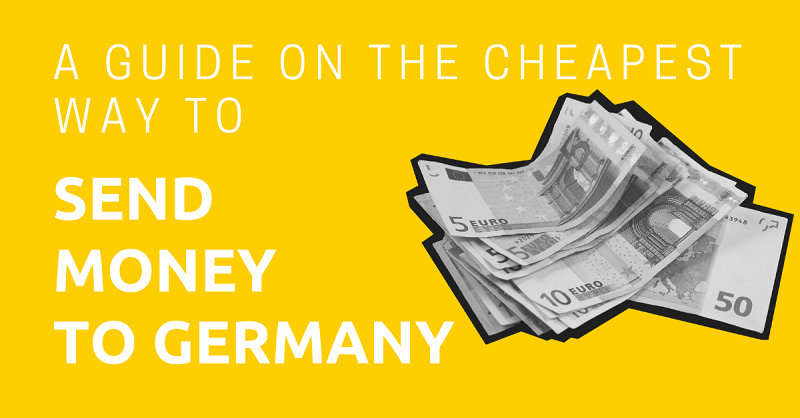
When sending money to Germany, most expats want to get the highest amount of cash on the receiving end in a timely manner.
We might not be able to escape the fact that we have to pay fees and settle for lower exchange rates, but that doesn’t mean we should settle for any old international money transfer service.
With that in mind, this guide will show you what to watch out for when transferring money into Germany and the cheapest services to use depending on the amount you want to send.
Before you get started on your transfer, it’s always a good idea to check the latest rates on Monito, as the website will show you which money transfer service provider will give you the cheapest rates for transferring cash into the country.
This article will take approximately 13 minutes to read. Don't have the time right now? No worries. You can email the ad-free version of the article to yourself and read it later!
Disclaimer: This article may include links to products or services offered by ExpatDen’s partners, which give us commissions when you click on them. Although this may influence how they appear in the text, we only recommend solutions that we would use in your situation. Read more in our Advertising Disclosure.
Contents
What to Watch Out for When Sending Money to Germany
Before you make an international money transfer into Germany, here are three important things you must consider.
Transfer Fees
Generally speaking, you’ll pay one of three types of fees when sending money from your home bank account to a bank account in Germany.
- fixed fee
- percentage fee
- combination fee
Let’s look at each one more closely.
Fixed Fees
A fixed fee is the first type of transfer fee you’ll come across when you send money to Germany, and does not change with the amount of money you transfer into the country.
Whether you send USD1,000 or USD10,000 you’ll be charged the same fee, which varies between banks and online money transfer service providers.
Bank of America, for example, charges USD45 no matter how much money you send to Germany, making a bank transfer one of the cheapest options for transfers over a few thousand dollars.
Percentage Fees
A percentage fee is another type of transfer you’ll come across, but as opposed to fixed fees, percentage fees change with the amount you send to Germany.
Wise for example, charges a percentage fee of 0.48 percent on a USD1,000 transfer, meaning you’ll pay roughly USD4.80 in Wise percentage fees (not including the ACH bank debit transfer fee — more on this later).
However, keep in mind that when using an online money transfer service and transferring with a credit card, you will be charged a 1 to 3 percent fee of the total amount you’re sending to Germany.
Combination Fees
The third type of fee you’ll come across when transferring money to Germany is the combination fee, which is a combination of a fixed fee and percentage fee.
PayPal uses this structure to charge for international money transfers.
Keep in mind that fee types don’t always predict whether a service is going to be cheaper or more expensive than the next.
Exchange rates also play an important role when getting cash into a German bank, so let’s look at how they can either save or cost you money.
Exchange Rates
It’s rare that banks and online money transfer service providers will give you mid-market rates (except for Wise), so be sure to check the exchange rate you’re quoted with the mid-market rate on XE.
Moreover, the service providers that don’t charge transfer fees — like Xendpay for the first GBP2,000 — make their money by taking a small cut of the exchange rate.
Xendpay, on average, takes about 2 percent to 3 percent of the mid-market exchange rate found on XE.
Aside from transfer fees and exchange rates, you also have to consider transfer speeds, which I’ll cover next.
Transfer Speeds
You may or may not be in a rush to get your money into Germany, but it’s good to know how long typical transfers will take in case you have to schedule monthly payments or need living expenses.
Using services like Wise, Xendpay, or banks will usually take one to three business days.
When using a service like Western Union, you can get your money in minutes, but be prepared to pay a lot more in fees.
If you go with the old school paper check, expect to wait months for that transfer to clear.
Now that you know what to consider when transferring money to Germany, let’s look at your options.
Money Transfer Service Options
When it comes to sending money from overseas into your German bank account, you have quite a few options.
Wise
Wise is one of the few online money transfer service providers that offers mid-market exchange rates, which makes them popular with expats in Germany.

You’ll pay a percentage fee for using its service, and compared to other providers its rates are competitive.
For example, on a USD1,000 transfer to Germany, they charge a percentage fee of USD4.80 along with the USD2.59 bank fee for ACH transfers — the cheapest option on its website. In the end, you’d wind up with EUR832.55.
However, that same USD1,000 transfer would cost more if you selected wire transfer, debit card, or credit card as a means of payment, especially since credit cards will take 1 percent to 3 percent of your transfer:
- wire transfer — USD5.64 fee
- debit card — USD11.56 fee
- credit card — USD37.44 fee
Moreover, Wise is fairly quick, promising one-day delivery if you make the transfer on Mondays through Thursdays.
As for security, Wise employs a dedicated fraud team, offers real-time notifications, data protection, and more.
You can use Wise on your computer or phone on either its Android and iOS app, and verification only takes a few minutes if you have documents ready.
Check out our in-depth review of Wise.
Xendpay
Xendpay is a great choice for first-time transfers, as they offer a “pay what you want” model for the first USD2,275 you send to Germany.

However, keep in mind that Xendpay does take a percentage of the currency exchange, usually 2 percent to 3 percent, but that doesn’t mean you should count them out.
Sending USD1,000 to Germany through Xendpay would get you EUR838, or about EUR5 more than wise.
Keep in mind that after your meet your initial USD2,275 limit, Xendpay will start adding in additional fees depending on your transfer method. Here they are:
- credit card — 2.3 percent fee
- debit card — 2.3 percent fee
When transferring money to Germany through Xendpay, you’ll get your money in one to three business days.
Xendpay also takes its security seriously. They offer data protection, partake in anti-money laundering programs, and use the latest internet security protocols.
You can transfer through Xendpay using its website or app for Android and iOS.
Bank Transfers
For transfers of up to a few thousand dollars, it’s best to avoid banks and stick to Wise or Xendpay.
However, with larger transfers, banks are usually the way to go because most of them charge a relatively small fixed fee along with their exchange rate fees.
It’s for this reason that banks tend to be the go-to transfer method for expats in Germany who need down payments on cars or property.
Using Bank of America, for instance, you’ll pay a fixed fee of USD45 no matter how much money you transfer into Germany.
However, Bank of America — and most other banks — don’t disclose exchange rate fees. With that said, though, it’s safe to assume they are taking 2 percent to 4 percent in fees for exchange rates.
Bank transfers are quick as well, with the money landing in your German account in one to two business days if sent before 5 pm.
The only drawback to using a bank is that the process is a lot more tedious than if using Wise or Xendpay, as your bank may not have a dedicated app for this service.
Western Union
Western Union is not the best choice for transferring money into Germany, but if you need money in a bind, it may become your go-to method.

It may not say that it’s charging you transfer fees, but Western Union is taking roughly 4 percent to 5 percent off the exchange rate.
With that in mind, if you send USD1,000 to Germany through Western Union using a bank transfer, you’d only get EUR817.90 at best.
For quicker transfers using the options below, the fees would increase:
- credit card — USD29.99
- debit card — USD2.99
If you opt for a bank transfer, you’ll have your money in one to five business days. For debit and credit card transfers, you’ll get your money in one day.
Having been the go-to money transfer service for decades, Western Union is secure, even if it is expensive.
However, its website is much more easier to use than if you were transferring money through a bank’s website.
PayPal
You can also transfer money to a bank account in Germany using PayPal’s service, Xoom.

Xoom is slightly better than Western Union, too. For a USD1,000 transfer into Germany, they’d take about 2 percent to 4 percent in exchange rate fees along with a debit or credit card fee of USD30.49 — sorry, no bank transfers allowed with Xoom.
PayPal’s Xoom does have one thing going for it — transfer speed. You can get your money in Germany in under three hours.
Xoom is also keen on security, as they use data encryption and fraud monitoring on all its transfers.
Its website is easy to use as well and ties in with your PayPal account. You can also use its app on Android and iOS.
ATM Withdrawals
Most of Germany’s major banks don’t charge ATM fees if you’re using your home country bank’s debit card, but privately-owned ATMs do.
In fact, they could charge up to EUR4.50 just to withdrawal some cash from their machines. The good thing is that they disclose the fee up front.
Keep in mind, however, that his is just the fee you’ll pay in Germany. You bank back home may also charge an ATM fee on top of that.
More so, those fees are in addition to the hidden exchange rate fees you’ll wind up paying for using an ATM.
Having said all that, it’s best to check with your home bank on how they deal with foreign ATM withdrawals. Some banks, like TD Bank, may even reimburse you for ATM fees in Germany.
But pick and choose when and why you withdrawal money from an ATM in Germany, as it will probably cost you the most over the long haul, especially if you are limited to only EUR500 withdrawals per day.
The good thing, though, is that you’ll receive your money in an instant — as long as the ATM is stocked with crisp bills.
Cryptocurrency
Germany’s capital, Berlin, was dubbed the Bitcoin Capital of Europe by The Guardian back in 2013 thanks to the widespread acceptance of the cryptocurrency in the city.
Having said that, if you want to cash out your Bitcoins for cash money, Germany currently has 56 Bitcoin ATM’s in the country.
German banks, however, do not offer currency exchange for cryptocurrencies.
The Best Method to Send Money To Germany
As you can see from the table below, Xendpay is your best choice when sending USD1,000 to Germany. As you get closer to USD10,000, however, bank transfers tend to yield more money on the receiving end.
| Method | Speed | USD1,000 | USD10,000 |
| Wise | 1 to 3 days | EUR832.80 | EUR8,328.50 |
| Xendpay | 1 to 3 days | EUR838.00 | EUR8,185.81 |
| Bank Transfers | 1 to 2 days | EUR800 | EUR8,341.52 |
| Western Union | 1 to 5 days | EUR817.90 | EUR8,179 |
| PayPal | 1 day | EUR823 | EUR8,230 |
| ATM | Instant | NA | NA |
| Cryptocurrency | NA | NA | NA |
With those general numbers in mind, let’s look at the options that are best for expats from specific countries.
Country-Specific Recommendation
If you’re sending money to Germany from the U.S., the U.K., or Canada here are your best choices.
United States
Xendpay is your best choice if sending a few thousand dollars to Germany from the U.S. But once you start getting close to the USD10,000 mark, your best bet is to use a bank transfer, such as through Bank of America.
However, if you find that your bank charges transfer fees higher than USD100 for USD10,000 transfers, you might want to to use Wise instead.
United Kingdom
When sending money from the U.K. to Germany, Xendpay is an excellent choice, especially since they offer a “pay what you want” model for international transfers up to GBP2,000. Once you reach your limit, you can switch to Wise if they offer better amounts on the receiving end.
For larger transfers, you may want to use a bank such as Barclay’s or HSBC UK. Barclay’s charges a fixed fee from GBP19 to GBP44 for all transfers, while HSBC UK charges up to GBP30.
Canada
If you have to send money from Canada to Germany, use Xendpay for the best rates, as they just eek out Wise when it comes to total amounts received.
For transfers nearing CAD10,000 or more, Scotiabank is your go-to method, as they are usually on the top of the list for expats, international travelers, and students abroad.
And it’s easy to see why that’s the case. Scotiabank only charges CAD19 for international money transfers into Germany.
Now, on to You
Now that you know the options you have when sending money to Germany, you can make a choice based on how much you’re going to send and from which country.
Having said that, remember to check out Monito to find out which money transfer service providers will get you the best rates.







